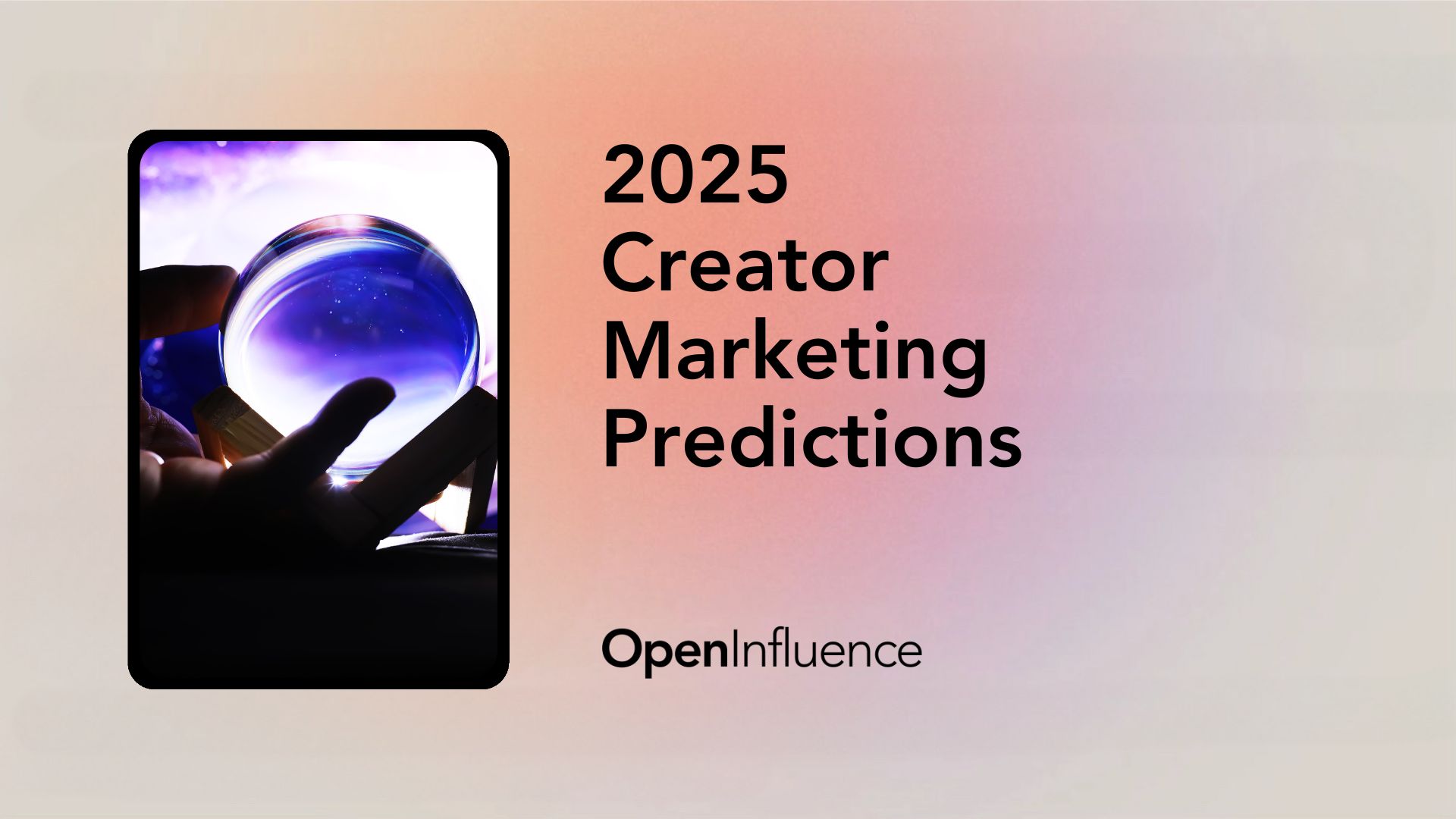As we step into 2025, the creator marketing landscape continues to evolve, offering brands exciting opportunities to grow and connect with their audiences in new ways.
While the fate of TikTok remains a headline-grabbing story, the year ahead promises innovation, diversification, and a deeper integration of creators into the marketing ecosystem.
Open Influence shared its predictions for the creator marketing sector in 2025. And you can look back at our predictions for 2024 and see how we did.
Platform Evolution and Diversification
TikTok’s future may be uncertain due to regulatory challenges, but its influence on the industry is undeniable. Regardless of the outcome, brands are embracing multi-platform strategies to ensure resilience. Emerging platforms like Bluesky, Lemon8, BeReal, Red Note, Clapper and WhatNot are gaining traction, while established players like Instagram and YouTube continue to innovate with new features to capture engagement.
“This shift could lead to a more diverse and dynamic ecosystem of social platforms, each vying for engagement with unique offerings and niche appeals, ” explained Jenifer Golden, Senior Director of Partnerships and Innovation at Open Influence.
Meanwhile, LinkedIn is evolving into a hub for creator-driven content. As professionals blend personal branding with career expertise, the platform is becoming a space for thought leadership and authentic storytelling.
“Creators, ranging from CEOs to niche industry experts, will use the platform to share thought leadership, industry insights, and authentic stories that engage a highly targeted professional audience,” noted Katie Elkind, OI Culture and Innovation Manager.
“Long-form posts, video commentary, and live discussions will drive valuable business conversations, making LinkedIn a hub for education and professional growth. Brands will collaborate with these influencers to reach decision-makers and build trust through authentic, value-driven content. This shift will humanize influencer marketing on LinkedIn, prioritizing credibility and meaningful connections over traditional promotional tactics.”
The Expanding Role of Creators
Creators are expanding their influence beyond social media, shaping campaigns across connected TV, digital out-of-home, and experiential marketing. This diversification reflects their growing importance in the broader media ecosystem.
“In the past, agencies and brands relied solely on internal creative teams to craft campaigns they hoped would resonate with their target audience. Today, brands can unlock the creative power of hundreds of thousands of creators from diverse backgrounds and perspectives to bring their stories to life in ways that are both authentic and impactful,” observed Maria A. Rodriguez, VP, Comms and Marketing at Open Influence.
“There’s no reason why this creativity should be limited to social media. We’re seeing creators drive innovation across all touch points, making them indispensable partners in shaping narratives that engage audiences wherever they are.”
The rise of micro-influencers is particularly significant. These creators, with smaller but highly engaged audiences, are proving to be powerful partners for brands. “Smaller influencers with loyal communities are outperforming mega-influencers in building trust and driving conversions,” said OI Co-Founder and Chief Operating Officer Joey Chowaiki.
What’s more, brands are increasingly recognizing that impact isn’t solely tied to follower counts. In many cases, the ability of creators to produce high-quality, authentic content is just as valuable—if not more. This content can often be repurposed across multiple channels, such as paid ads, websites, email campaigns, and even out-of-home advertising, maximizing its value and reach.
Additionally, long-term partnerships between brands and creators are gaining momentum. By moving away from one-off collaborations, brands and creators can foster sustainable relationships that deliver measurable results. “This approach ensures both parties are invested in success, leading to deeper connections and organic growth,” Elkind added.
Content Trends in 2025
The content landscape continues to balance the appeal of short-term viral moments with the increasing priority of evergreen narratives. While fleeting trends can create buzz, brands are focusing more on meaningful campaigns that resonate deeply with audiences and maintain relevance over time.
“Brands are moving beyond short-term trends to focus on enduring themes that build deeper connections with audiences,” said Elkind.
1. Long-Form Content and Immersive Experiences
Platforms like YouTube are at the forefront of long-form, episodic content, offering brands the opportunity to engage audiences with narrative-driven campaigns. These formats build anticipation, foster audience retention, and naturally integrate branded messaging.
In addition, immersive experiences such as brand trips, events, and in-person activations are gaining momentum. These hands-on interactions strengthen bonds between brands, creators, and their audiences.
“These experiences create memorable moments that amplify emotional connections and drive engagement,” Elkind explained.
-
Content and Commerce Integration
The integration of content and commerce continues to revolutionize how brands engage audiences, enabling creators to turn influence into measurable results. Collaborative collections, creator-branded merchandise, and social commerce are creating seamless links between storytelling and shopping.
“2025 will see the seamless blending of content and commerce,” said Golden.
Social commerce is projected to grow significantly, with sales expected to exceed $82 billion in 2025. This presents new opportunities for micro- and nano-influencers to drive targeted sales within niche audiences. “For marketers, the rise of social commerce offers valuable data insights, allowing them to optimize campaigns and strengthen consumer relationships,” Elkind said. “Ultimately, the rise of social commerce solidifies influencers’ role in shaping purchasing behavior and positions them as key players in the future of brand marketing.”
Live commerce will also play an increasingly central role. “Live commerce will continue to grow. Shoppable posts and in-app purchases will become staples of influencer campaigns,” Chowaiki explained.
One platform gaining traction in the live commerce space is Whatnot, a livestream marketplace specializing in collectibles like sports cards, sneakers, comics, and vintage clothing.The start up has raised $265 million in funding. The company iis seen by investors as a potential go-to platform for live creators and shoppers should TikTok face regulatory challenges.
As live commerce continues to evolve, platforms like Whatnot demonstrate the growing opportunity for brands to tap into niche markets while leveraging creators to bring authenticity and creativity to the shopping experience. This dynamic blend of content and commerce is redefining how brands connect with their customers and drive measurable results.
3. Diversity, Inclusion, and Creator Well-Being
Diversity, equity, and inclusion remain integral to content strategies. Open Influence has partnered with SeeMe Index to incorporate exclusivity data into its campaigns. “Brands are recognizing the need to connect with audiences authentically by championing creators from all walks of life,” Golden added.
Elkind also expects mental health to become a greater focus within the creator community. “Partnerships with wellness platforms and initiatives that support creator well-being will become a key differentiator,” she explained.
The Role of Technology in Creator Marketing
Technology, particularly artificial intelligence (AI), is revolutionizing creator marketing by streamlining campaign execution and enhancing efficiency. AI tools are enabling brands to identify the right creators, predict campaign performance, and optimize audience targeting, creating a more impactful and data-driven approach to campaigns.
“AI is reshaping how brands and creators collaborate, making campaigns more impactful and efficient,” Chowaiki, said. “AI tools will streamline influencer selection, content creation, and audience targeting, making campaigns more efficient and impactful.”
AI is not only transforming brand processes but also empowering creators. “AI tools will enable creators to produce higher-quality content faster, from editing to animation,” said Rodriguez. “This efficiency allows creators to focus on storytelling, while brands benefit from rapid execution and innovative, scalable creative outputs.”
In addition to streamlining workflows, we anticipate exponential growth in the use of AI-powered creators—virtual influencers and AI-generated content creators. These AI creators, already making waves in the industry, offer unique opportunities for brands to experiment with innovative storytelling and targeted messaging.
Conclusion
As we look ahead to 2025, one thing is clear: creators are here to stay and remain central to shaping the narratives that resonate with audiences. Their ability to connect authentically and drive meaningful engagement cements their place at the heart of modern marketing strategies.
At the same time, the creator marketing landscape is dynamic, and rapid advancements in technology and platform innovations mean that new opportunities and trends are constantly emerging. While our predictions provide a roadmap for what’s to come, we’re keeping a close eye on developments throughout the year to ensure we stay ahead of the curve. Join us on this journey, and let’s see how 2025 unfolds together.
Open Influence’s team stays on top of the latest trends and is here to help you maximize your creator campaigns. Open Influence is a leading global creator marketing agency dedicated to creating engaging campaigns.






